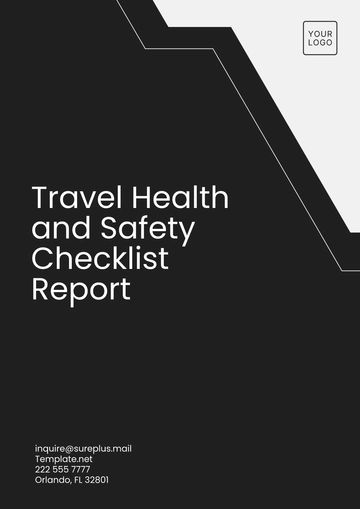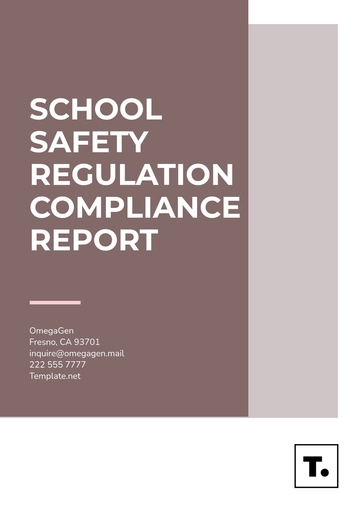Sample Workplace Health and Safety Report
Prepared by: [Your Name]
Company: [Your Company Name]
Date: June 1, 2055
1. Introduction
The purpose of this Workplace Health and Safety Report is to provide a comprehensive overview of the current state of health and safety within our organization. This report examines safety statistics, identifies potential hazards, evaluates compliance with regulatory standards, and offers actionable recommendations for improvement. Ensuring a safe working environment is essential for the well-being of our employees, minimizing operational disruptions, and safeguarding the organization’s reputation.
2. Safety Statistics
2.1 Incident Overview
Over the past year, the organization has recorded a total of 15 safety incidents, ranging from minor injuries to severe cases requiring medical attention. A detailed analysis has been conducted to determine root causes and to propose preventive measures.
2.2 Incident Types
Incident Type | Number of Cases | Percentage |
|---|
Slips, Trips, and Falls | 6 | 40% |
Equipment-Related Injuries | 4 | 26.7% |
Ergonomic Injuries | 3 | 20% |
Other | 2 | 13.3% |
The data indicates that slips, trips, and falls are the most frequent type of incident, emphasizing the need for improved floor maintenance, training, and hazard awareness.
2.3 Lost Time Injury Frequency Rate (LTIFR)
The LTIFR for this reporting period is 2.5 per million hours worked, representing a 0.5 increase from the previous year. This upward trend calls for immediate action to identify and mitigate risks effectively.
2.4 Near Misses and Observations
In addition to recorded incidents, 25 near misses were reported. While these did not result in injury, they highlight critical areas of potential risk and underscore the importance of a proactive safety culture.
3. Hazard Identification and Risk Assessment
Hazard identification and risk assessments are pivotal in maintaining a safe workplace. The recent assessments identified the following hazards and corresponding mitigation strategies:
3.1 Physical Hazards
Mitigation:
3.2 Chemical Hazards
Mitigation:
3.3 Ergonomic Hazards
Mitigation:
4. Compliance with Regulatory Standards
The organization remains committed to adhering to all relevant workplace health and safety regulations. Regular audits and reviews are conducted to assess compliance.
4.1 Areas of Compliance
Safety signage is up-to-date and visible.
Fire safety equipment is properly maintained and accessible.
Employee health checks and medical records are maintained as per legal requirements.
4.2 Areas of Non-Compliance
Inadequate personal protective equipment (PPE) availability for certain tasks.
Emergency exit pathways are occasionally blocked by stored materials.
Noise levels in certain production areas exceed recommended standards.
5. Safety Initiatives
5.1 Employee Training and Engagement
5.2 Emergency Preparedness
5.3 Technology Integration
Implement digital incident reporting systems for real-time tracking and analysis.
Leverage IoT devices to monitor workplace conditions such as air quality, temperature, and noise levels.
6. Recommendations for Improvement
Based on the findings of this report, the following recommendations are proposed to enhance workplace health and safety:
Conduct mandatory safety training sessions for all employees, with a focus on hazard awareness and safe work practices.
Establish a rigorous equipment inspection and maintenance program.
Improve floor cleaning and maintenance schedules to mitigate slips and falls.
Enforce strict guidelines to keep emergency exit pathways clear at all times.
Increase the availability and proper fitting of PPE.
Integrate advanced monitoring systems to identify hazards in real time.
Develop targeted initiatives to reduce ergonomic injuries, such as personalized workstation assessments.
7. Monitoring and Evaluation
To ensure continuous improvement in workplace safety, the following measures will be implemented:
Monthly safety audits to track progress and compliance.
Establishing KPIs such as a reduction in LTIFR and near-miss incidents.
Regular feedback sessions with employees to identify emerging risks.
8. Conclusion
The safety and well-being of our employees are integral to the success and sustainability of the organization. This report highlights the current safety performance, identifies critical areas for improvement, and provides a roadmap for achieving a safer workplace. By implementing the outlined recommendations and fostering a culture of safety, the organization can minimize risks, enhance employee morale, and maintain regulatory compliance.
Report Templates @ Template.net






























